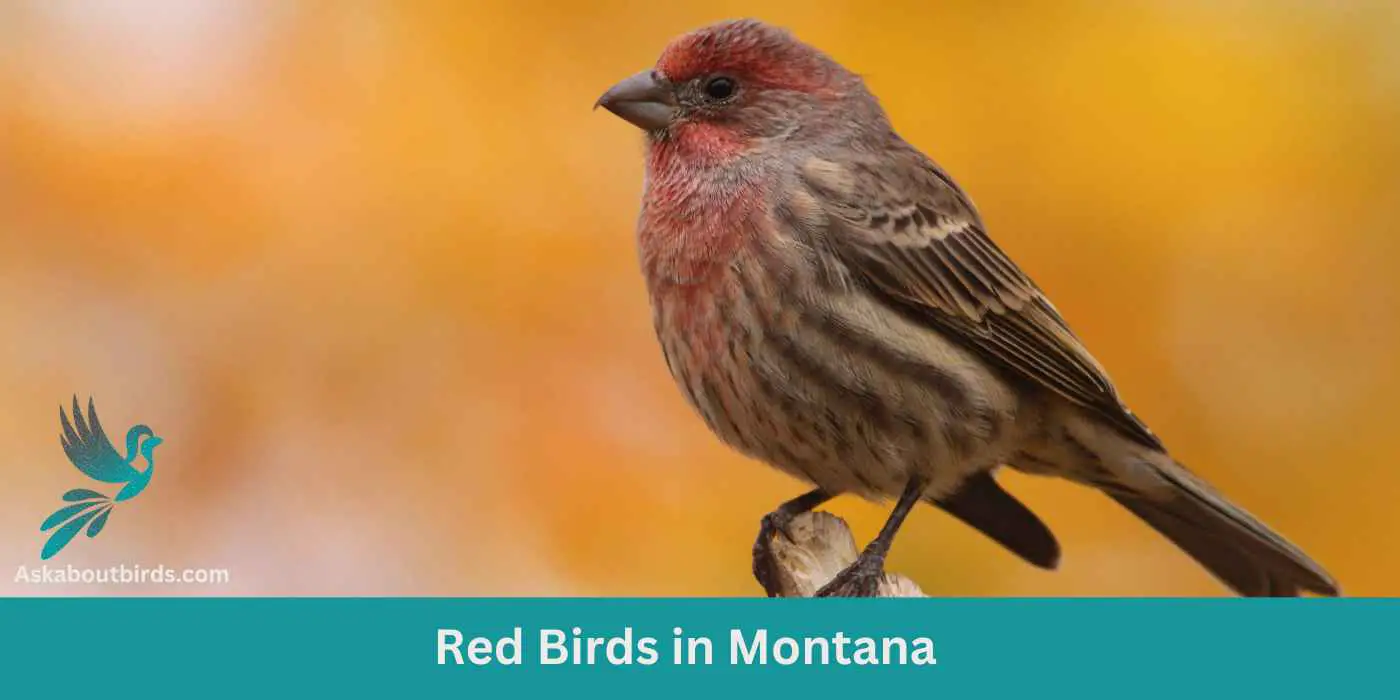Montana, often celebrated for its sweeping landscapes and majestic mountains, is also home to a fascinating tapestry of avian life. Among its winged residents, the red-feathered species stand out, adding a splash of vibrant color to the Big Sky Country.
Dive into this curated list of 10 resplendent red birds that grace Montana’s skies and don’t forget to grab your free photo guide to enhance your birdwatching experience!
Red Birds Found In Montana
The geographical mosaic that Montana offers is a haven for a wide spectrum of birdlife. The juxtaposition of towering mountain ranges and expansive grasslands creates a unique blend of habitats.
The state’s abundant water sources, including rivers, lakes, and wetlands, further augment its attractiveness for avian species. Such a versatile and accommodating environment is a magnet for both migratory and resident birds, making Montana a birdwatcher’s paradise.
Northern Cardinal


| Feature | Measurement |
|---|---|
| Scientific Name | Cardinalis cardinalis |
| Length | 8.3 – 9.1 in |
| Wingspan | 9.8 – 12.2 in |
| Weight | 1.19 – 2.29 oz |
The Northern Cardinal is an iconic North American bird, easily recognized by its vibrant color and melodious song.
Appearance: Male Northern Cardinals are a brilliant scarlet red, while females display a more subdued reddish olive. Both sexes have a distinctive black ‘mask’ on their face around the bill and a pointed crest on their head. The bird’s beak is robust, cone-shaped, and bright orange in color.
Diet: Northern Cardinals are primarily granivorous, with a diet largely consisting of seeds and grains. They also eat fruits and insects. These birds typically feed off the ground and are frequent visitors to bird feeders.
Reproduction: Northern Cardinals are monogamous, and a pair will breed together for life. The female typically builds a well-hidden nest in a dense thicket or shrub. She lays 2-5 eggs per clutch, which she incubates for around two weeks.
Red Crossbill

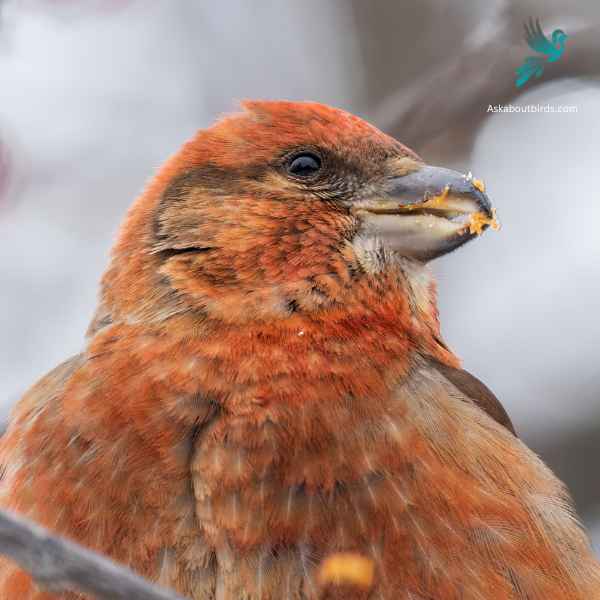
| Feature | Measurement |
|---|---|
| Scientific Name | Loxia curvirostra |
| Length | 5.5–7.5 in |
| Wingspan | 9.8–10.6 in |
| Weight | 0.9–1.4 oz |
The Red Crossbill is a distinctive finch known for its unusual bill, which has evolved to extract seeds from conifer cones.
Appearance: Males are typically bright red or orange, while females are greenish-yellow or olive. Both genders have the characteristic crossed bill, which they use to expertly extract seeds from tightly closed conifer cones.
Diet: Red Crossbills primarily feed on the seeds of coniferous trees, such as spruce, pine, and fir. Their specialized bills allow them to efficiently pry apart conifer cone scales to access the seeds.
Reproduction: Red Crossbills are somewhat nomadic and don’t adhere to a strict breeding schedule. Instead, they breed whenever and wherever food is abundant. Their nests are usually built on horizontal branches of conifer trees.
House Finch


| Feature | Measurement |
|---|---|
| Scientific Name | Haemorhous mexicanus |
| Length | 5–6 in |
| Wingspan | 8–10 in |
| Weight | 0.6–0.9 oz |
The House Finch is a small songbird widely distributed across North America and is commonly found in urban and suburban areas.
Appearance: Males of this species are brightly colored with crimson faces and throats, which can extend to the chest and back, while their flanks have streaks. The female is streaked brown and lacks the red coloring. Both have a square-tipped tail and a distinctively long, flat-topped bill.
Diet: House Finches primarily eat seeds, grains, and berries. They have a particular fondness for sunflower seeds and can be commonly seen at bird feeders. Occasionally, they will also consume insects, especially during the breeding season.
Reproduction: House Finches are cavity-nesters and might choose ledges, vents, ledges, and other urban settings. They might also utilize trees or shrubs. Their nests can be made of a wide array of materials, from feathers to twigs.
Pine Grosbeak

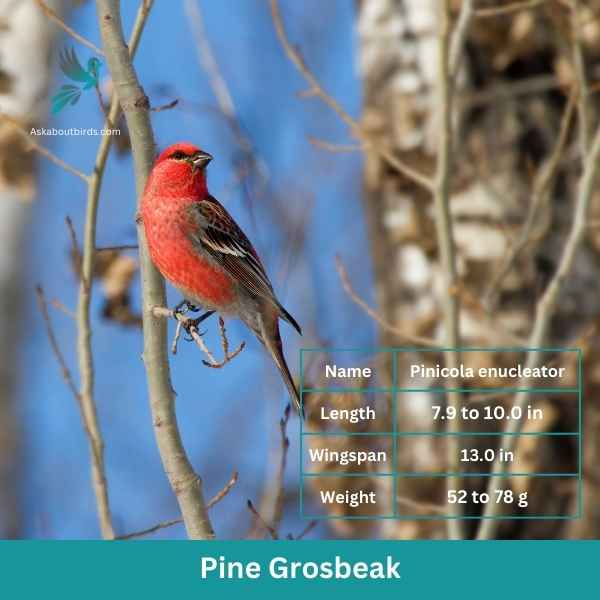
| Feature | Measurement |
|---|---|
| Scientific Name | Pinicola enucleator |
| Length | 7.9 to 10.0 in |
| Wingspan | 13.0 in |
| Weight | 52 to 78 g |
The Pine Grosbeak is a striking bird native to the northern regions of North America, often found in coniferous forests. Both males and females have a plump and robust body with a large beak adapted for eating seeds. The male Pine Grosbeak displays a vibrant reddish-pink plumage, while the female has a more subdued grayish-brown coloration.
These birds are typically seen in small flocks, foraging for food in trees and on the ground. They have a preference for seeds, particularly those from various conifer species. The Pine Grosbeak uses its strong bill to crack open the cones of tall trees and extract the seeds, but they also consume berries and small fruits when available.
Cassin’s Finch

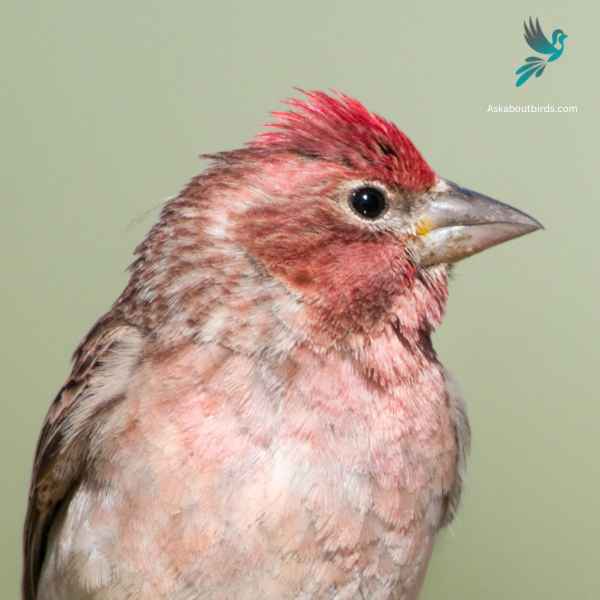
| Feature | Measurement |
|---|---|
| Scientific Name | Haemorhous cassinii |
| Length | 6.0-6.5 in |
| Wingspan | 9.5-10.5 in |
| Weight | 0.8-1.0 oz |
The Cassin’s Finch is a small songbird known for its melodic song and affinity for high-elevation forests.
Appearance: Male Cassin’s Finches are pinkish-red on the crown and throat, contrasting with their streaked brown back and wings. Females lack the bright coloring, appearing streaked brown throughout with a pale eyebrow stripe. Both sexes have a notched tail and a slightly curved bill.
Diet: Cassin’s Finches mainly feed on seeds, particularly from conifers. They also eat insects, especially during the breeding season. Their feeding habits often bring them to bird feeders where they readily eat sunflower seeds.
Reproduction: Cassin’s Finches nest in trees, preferring coniferous forests. The nest is made from twigs, grasses, and feathers. Typically, the female lays 3 to 5 eggs and handles most of the incubation. Both parents partake in feeding the fledglings once they hatch.
Purple Finch


| Feature | Measurement |
|---|---|
| Scientific Name | Haemorhous purpureus |
| Length | 4.7–6.3 in |
| Wingspan | 4.7–6.3 in |
| Weight | 0.6–1.1 oz |
The Purple Finch is a vibrant songbird often mistaken for its close relative, the House Finch, but it exhibits a different hue and patterns.
Appearance: Males are raspberry red on the head, throat, and breast, with streaky brown backs and wings. The intensity of the red can vary among individuals. Females are brown and streaked all over but might show a slight blush on the face. They lack the strong facial patterns seen in female House Finches.
Diet: Purple Finches primarily consume seeds, with a preference for sunflower seeds, dandelion seeds, and buds. They also eat insects and berries, especially during the breeding season.
Reproduction: These finches often nest in conifers or mixed woodlands. The nest, typically located on a horizontal branch, is made from twigs and grass, then lined with feathers.
Western Tanager

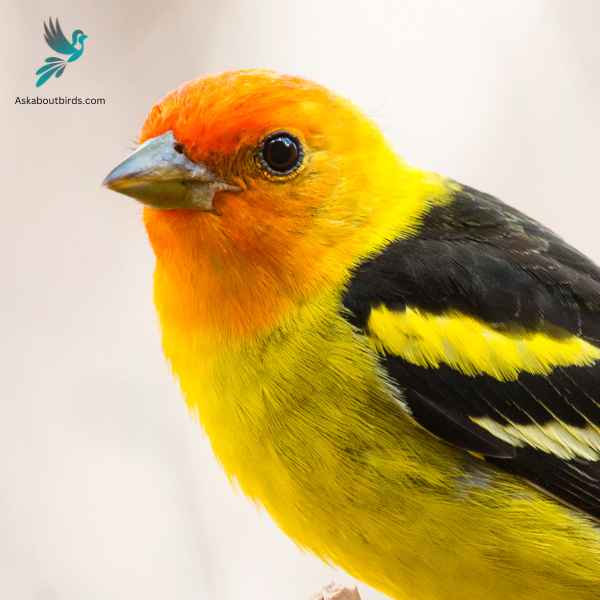
| Feature | Measurement |
|---|---|
| Scientific Name | Piranga ludoviciana |
| Length | 6.3-7.5 in |
| Wingspan | 11.5 in |
| Weight | 24-36 g |
The Western Tanager is a vibrant songbird that graces the forests and woodlands of the western regions of North America, enchanting observers with its colorful plumage and melodious song.
Appearance: The male Western Tanager is renowned for its bright yellow body contrasted with a striking red head and black wings and tail. The females are more subdued in hue, primarily being yellow with grayish wings and back, and lacking the brilliant red head of the males.
Diet: Western Tanagers primarily feed on insects, especially when breeding, but they also incorporate a significant amount of fruits and berries into their diet, especially during migration and winter.
Reproduction: Western Tanagers build their nests high in coniferous trees, often well concealed from potential predators. The female usually lays a clutch of 3 to 5 eggs and takes the primary role in incubation, while both parents are involved in feeding the chicks after they hatch.
American Robins


| Feature | Measurement |
|---|---|
| Scientific Name | Leptotila plumbeicep |
| Length | 10.6-11.8 in |
| Wingspan | — |
| Weight | 160-200 g |
The American Robin is a widely recognized bird species known for its melodious song and early bird tendencies.
Appearance: American Robins are medium-sized birds with a distinctive appearance. Both males and females sport a gray to brown back and a warm red to orange breast and belly and gray wings. They also have a characteristic white eye-ring and a black head, but males are usually darker than females.
Diet: American Robins have a diverse diet that changes depending on the season. In summer, they feed heavily on earthworms, beetles, and other invertebrates, which they catch on the ground. During winter, they mostly eat fruits and berries.
Reproduction: American Robins usually build their nests in trees or shrubs, but they are also known to nest on human-made structures. The female lays a clutch of about 3 to 5 eggs, which she incubates for about 12 to 14 days.
Rufous-sided (Eastern) Towhee
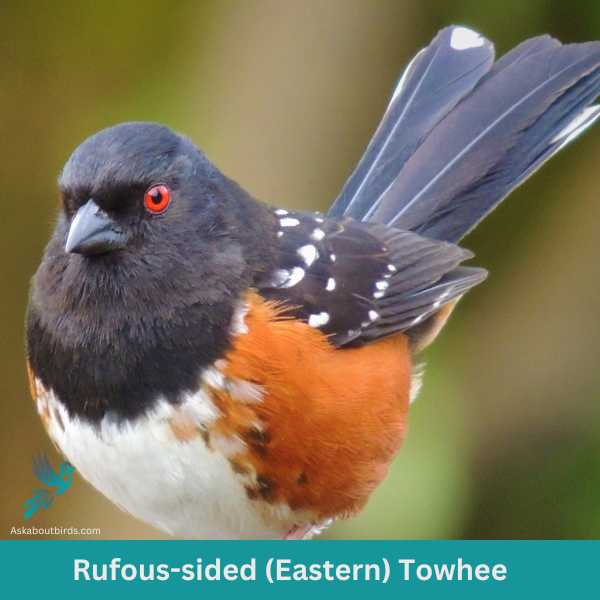
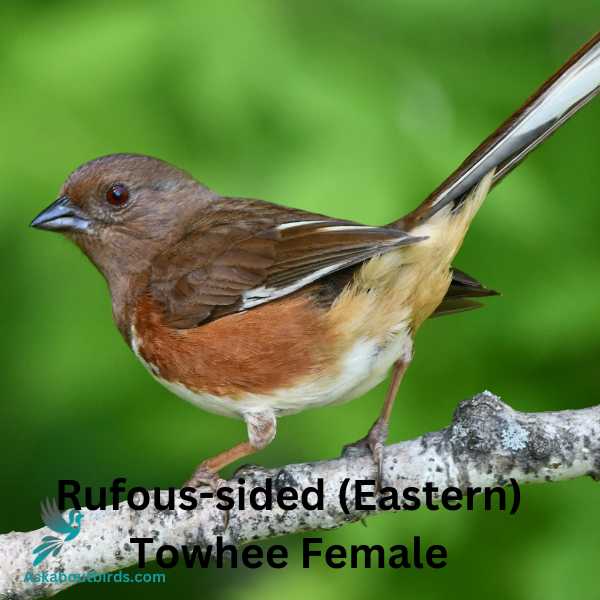
| Scientific Name | Pipilo erythrophthalmus |
| Length | 6.75 to 8.25 inches |
| Wingspan | 7.9 to 11 inches |
| Weight | 1.1 to 1.8 ounces |
The Rufous-sided Towhee, more commonly known as the Eastern Towhee, is a striking bird distinguished by its vivid coloration and melodious calls.
Appearance: Male Eastern Towhees are characterized by their black upper bodies, rufous flanks, and white underbellies. Females share the same pattern but are brown where the males are black. Both sexes have a distinctive red eye.
Diet: Eastern Towhees primarily feed on the ground, rummaging through leaf litter for seeds, berries, and insects. Their diet can vary seasonally, with more insects in warmer months and seeds during winter.
Reproduction: Eastern Towhees nest on or near the ground, typically in shrubs or dense vegetation. The female constructs the nest and incubates a clutch of 2 to 5 eggs, which hatch after about 12 days.
Summer Tanager


| Feature | Measurement |
|---|---|
| Scientific Name | Piranga rubra |
| Length | 6.7 in |
| Wingspan | 28 to 30 cm |
| Weight | 29 g |
The Summer Tanager is a medium-sized songbird admired for its radiant plumage and melodious song.
Appearance: Male Summer Tanagers are an impressive bright red, while females and juveniles present a softer, yellow-orange color. Both genders have a large, slightly hooked bill and relatively short tail.
Diet: Summer Tanagers primarily feed on insects, including bees and wasps, which they catch in flight or pick off vegetation. They are also known to eat fruits and berries, making them helpful in controlling pest populations and seed dispersal.
Reproduction: The female Summer Tanager builds a loose, shallow cup-shaped nest out of twigs and grass, usually hidden in the foliage of trees. The female typically lays 3-5 eggs, which she will incubate for about two weeks.
Where to Spot Montana’s Red Birds
Montana’s Diverse Birdwatching Havens:
- National Bison Range, Moiese: A unique habitat where grasslands meet forests, offering sightings of red birds amidst a backdrop of bison herds. Wetlands in the area also attract various waterfowl.
- Lee Metcalf National Wildlife Refuge, Stevensville: Spanning over 2,800 acres, this refuge is a hotspot for bird enthusiasts, with its combination of wetlands, grasslands, and forests hosting a variety of avian species.
- Ninepipe National Wildlife Refuge: Situated in the Flathead Valley, this area boasts a complex of wetlands, drawing both waterfowl and songbirds. The serene surroundings also provide a tranquil birdwatching experience.
- Benton Lake National Wildlife Refuge, Great Falls: A prime location for wetland birds, its shallow lakes and grasslands are home to numerous species, making it a sought-after spot for bird photographers.
- Beartooth Wildlife Management Area, Helena: Nestled in the mountainous region, this area provides habitats ranging from alpine meadows to dense coniferous forests, ensuring a varied birdwatching experience.
| State’s Red Birds | Top Spots for Red Birds |
|---|---|
| Idaho’s Red birds | 1. Coeur d’Alene Lake 2. Camas National Wildlife Refuge 3. Ponderosa Pine Scenic Byway |
| Wyoming’s Red birds | 1. Yellowstone National Park 2. Seedskadee National Wildlife Refuge 3. Bighorn Canyon National Recreation Area |
| South Dakota’s Red birds | 1. Badlands National Park 2. Sand Lake National Wildlife Refuge 3. Custer State Park |
| North Dakota’s Red birds | 1. Theodore Roosevelt National Park 2. Lostwood National Wildlife Refuge 3. Arrowwood National Wildlife Refuge |
FAQs on Red Bird Species Found in Montana
What unique attributes differentiate White Winged Crossbills from other bird species?
White winged crossbills are distinctive birds, especially recognized for their two white wing bars. Native to northern and western states, these stunning birds exhibit brown plumage, contrasting with their white wing patches and darker wings. Often found in forest edges and the forest canopy, they predominantly feed on conifer seeds, specifically from pine cones, which sets them apart from other birds.
How does the feeding preference of Pine Grosbeaks differ from other backyard birds?
Pine grosbeaks, primarily found in the northern border regions like the Flathead National Forest, display a strong inclination towards sunflower seed feeders. Unlike other birds, such as the red-winged blackbird or the northern flicker, pine grosbeaks are more attracted to backyard feeders filled with black oil sunflower seeds. Their diet can also include berries from berry bushes, emphasizing their diverse palate.
What are the characteristics of the Scarlet Tanagers observed in the eastern and southern states?
Scarlet tanagers are radiant birds native to eastern and southern states, boasting striking red plumage contrasted by green wings. Their vibrant appearance differentiates them from birds with dull orange heads or those with brown coloring. While they do visit bird feeders, especially those offering black oil sunflower seeds, they are also commonly seen flitting through the forest canopy, hunting for insects.
How is the Montana Natural Heritage Program contributing to bird conservation?
The Montana Natural Heritage Program plays a pivotal role in bird conservation, particularly focusing on accidental species and birds native to the region. This program gathers and disseminates data about species found in places like the Fort Peck Indian Reservation. Their initiatives, combined with organizations like the Cornell Lab, offer insights into bird migration patterns, breeding habitats, and the effects of environmental changes on birds such as the pine grosbeaks and rose-breasted grosbeaks.

